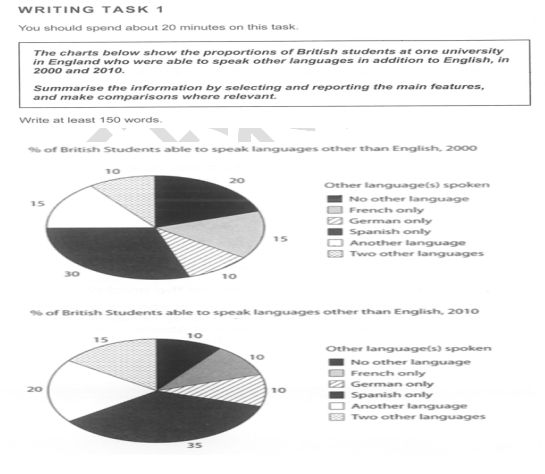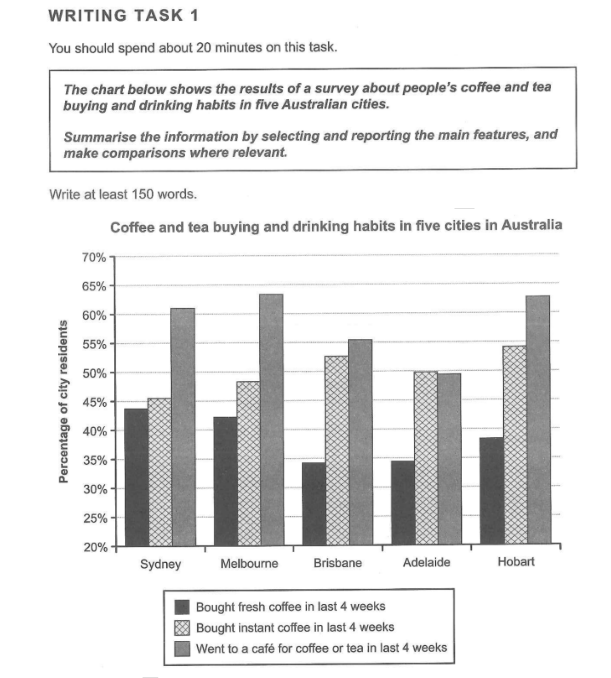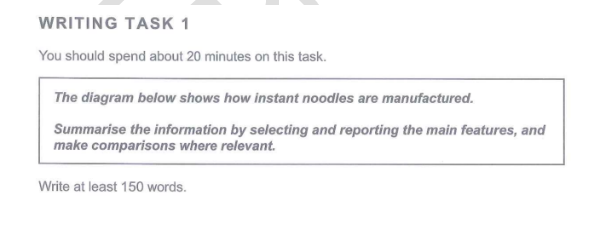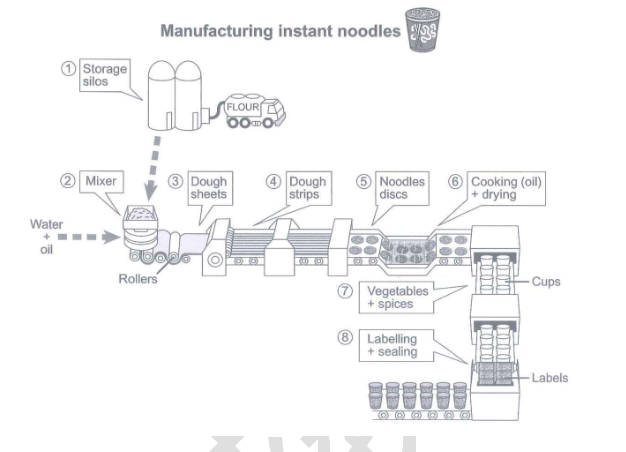雅思小作文重点预测题目来啦!
雅思小作文重点预测题目来啦!十月份的考试算是近几个月唯一没有出现非数据图表的月份。整体考情都是比较基础的数据型图表,动态和静态各半。相信这个趋势会延续到十一月份。就非数据图表而言,流程图出现几率大于地图题,下面就详细看看吧!如需完整版PDF,戳客服即可领取!
1, 动态图

The comparison of the percentage of British students in a university in England who spoke different languages other than English is illustrated by these two pies.
In 2000, 20% of students there could not speak any other language, 5% more than those who could use French as a second language. 10 years later, the percentage of these two groups both shrank to 10%. However, the percentage of who were able to speak Germen only in addition to English remained stable at 10% in both 2000 and 2010.
Spanish was the only foreign language for 30% of students in 2000, 15% and 20% higher than who could speak another language (15%) and two other languages (10%) respectively. The proportion of all these three items increased by 5%, occupying 35%, 20% and 15% in 2010 separately.
To sum up, besides English, it is obvious that Spanish was the most popular language for those British students. Meanwhile, fewer students could not use any foreign languages, whereas more of them were able to speak 3 or 4 languages.
2, 静态柱状图

The statistics (measured as a percentage) of people’s drinking and buying habits on coffee and tea in five Australian cities from a survey is indicated by this bar chart.
To begin with, 44% residents in Sydney bought fresh coffee in last 4 weeks, a bit higher than Melbourne (43%) and Hobart (38%) respectively. Nearly 35% of people living in Adelaide did the same thing, slightly more than Brisbane (34%).
Additionally, in terms of those who bought instant coffee in last 4 weeks, figures of all five cities are higher than 45%, with Hobart accounting for the highest proportion at 54%, followed by Brisbane (53%), Adelaide (50%), Melbourne (48%) and Sydney (46%) in a decreasing order.
More interestingly, as for people who went to a café for coffee or tea in last 4 weeks, proportions of 4 cities are more than a half, with Melbourne occupying the largest percentage at 64%, Hobart 63%, Sydney 61%, and Brisbane a little more than 55%. Meanwhile, the figure of Adelaide is a slightly lower than 50%.
In summary, in 4 cities excluding Adelaide, the most popular habit is going to a café for coffee or tea since related figures are noticeably higher than the other two options. In the meantime, in Adelaide instant coffee is prevalent because almost half local people chose it during last 4 weeks. In contrast, purchasing fresh coffee is the last choice for people in all these 5 cities.
3, 流程图


It is illustrated by this flow chart how instant noodles are produced in the production line. The whole process includes 8 clear steps.
In the first step, flour is transported to storage silos by trucks, and then it is mixed with water and oil in a mixer. Going through rollers, the mixture becomes dough sheets, which will be cut into dough strips and then processed into noodles discs over the next two steps. Thereafter, these discs are ready to be fried by cooking oil and then will be dried. In the next step, each dried disc will be put into a cup and then covered by some vegetables and spices. In the last step, those cups are labelled and sealed. Finally, the whole process is completed by those instant cup noodles being packaged.
In summary, for the production of instant noodles, flour, water, oil, vegetables, and some spices should be prepared as ingredients and seasoning. Meanwhile, after flour, oil and water is mixed, the dough will be rolled into sheets, cut into stripes, processed into discs, and deep fried. Subsequently, dried noodles discs will at last be packaged with some condiments.
- 上一条:雅思写作大作文权威预测,供参考!
- 下一条:雅思大作文解析:自由选课or必修数学
猜你喜欢
-
 大陆雅思大作文解析:科研应该由政府控制和开展2021-09-23大陆雅思大作文解析:科研应该由政府控制和开展,这是一道观点类大作文,讨论的是科学研究是否应该由政府控制而不是私人公司。要注【 查看详情 】
大陆雅思大作文解析:科研应该由政府控制和开展2021-09-23大陆雅思大作文解析:科研应该由政府控制和开展,这是一道观点类大作文,讨论的是科学研究是否应该由政府控制而不是私人公司。要注【 查看详情 】 -

-

-
 你真的会利用雅思写作例文吗?听听雅思写作老师怎么说!2021-10-17你真的会利用雅思写作例文吗?我们先来解决一个问题,是读例文还是背例文?读雅思例文已然成为了所有烤鸭们的必修课,这毋庸置疑。但是【 查看详情 】
你真的会利用雅思写作例文吗?听听雅思写作老师怎么说!2021-10-17你真的会利用雅思写作例文吗?我们先来解决一个问题,是读例文还是背例文?读雅思例文已然成为了所有烤鸭们的必修课,这毋庸置疑。但是【 查看详情 】
热门阅读
随机阅读















